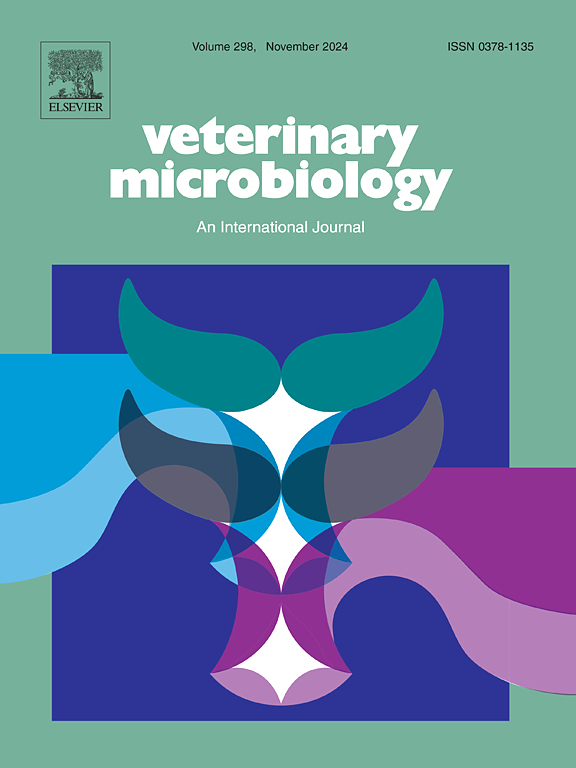农村条件下Fonni犬人畜共患病病原体的血清流行率及相关血液学和生化特征
IF 2.7
2区 农林科学
Q3 MICROBIOLOGY
引用次数: 0
摘要
Fonni的狗是地中海地区土生土长的犬种,特别是来自撒丁岛(意大利)。共对190只犬进行了检查,以确定该地区不同地方性病原体的血清阳性率和相关的血液学特征。立克次体、犬埃利希体、无形体的血清阳性率分别为65.0% %、41.3% %、28.7% %和18.9% %。分别为嗜吞噬菌和巴尔通体。婴儿利什曼原虫和刚地弓形虫血清阳性率相同,分别为5.6% %。血清共阳性病原菌数量对血液学指标没有影响,而年龄对白蛋白(ALB)、碱性磷酸酶(ALP)、钙(CAL)、总胆固醇(COL)、肌酸磷酸激酶(CPK)、肌酐(CRE)、天冬氨酸转氨酶(GOT)、脂肪酶(LIP)、磷(P)、总蛋白(PRO)和甘油三酯(TRI)等指标有影响。评估的病原体影响不同的参数。具体来说,立克次体降低CPK活性,肌酸和葡萄糖水平,增加磷。弓形虫增加CPK活性,降低葡萄糖水平,犬E.降低γ -谷氨酰转移酶(GGT)活性。最后,婴儿乳杆菌血清阳性降低CPK,增加GOT活性。在Fonni犬中观察到的与婴儿乳杆菌血清阳性率和相关血液学参数相关的结果表明,该犬种在面对该病原体时可能表现出与其他犬种不同的行为。需要进一步的研究来阐明这些差异的原因。本文章由计算机程序翻译,如有差异,请以英文原文为准。
Seroprevalence of zoonotic pathogens and related haematological and biochemical profiles in Fonni’s dogs in rural conditions
Fonni’s dog is a canine breed autochthonous to the Mediterranean area, specifically from Sardinia (Italy). A total of 190 dogs were examined to determine the seroprevalence of different pathogens endemic in this region and related haematological profile. The seropositivity of pathogens was 65.0 %, 41.3 %, 28.7 %, and 18.9 % for Rickettsia spp., Ehrlichia canis, Anaplasma. phagocytophilum, and Bartonella spp., respectively. Leishmania infantum and Toxoplasma gondii presented the same seroprevalence (5.6 %) respectively. The number of pathogens in co-seropositivity did not change the haematological parameters evaluated, whereas the age had an effect on several of them, including albumin (ALB), alkaline phosphatase (ALP), calcium (CAL), total cholesterol (COL), creatine phosphokinase (CPK), creatinine (CRE), aspartate aminotransferase (GOT), lipase (LIP), phosphorus (P), total protein (PRO) and triglycerides (TRI). Pathogens evaluated influenced different parameters. Specifically, Rickettsia spp. decreased CPK activity, creatine and glucose levels and increased phosphorus. T. gondii increased CPK activity and decreased glucose levels, and E. canis decreased gamma glutamyl transferase (GGT) activity. Finally, L. infantum seropositivity decreased CPK and increased GOT activities. The results observed in Fonni’s dogs related to seroprevalence of L. infantum and associated haematological parameters indicate that this canine breed could exhibit different behaviour from that of other canine breeds when faced with this pathogen. Further studies are necessary to elucidate the cause of these differences.
求助全文
通过发布文献求助,成功后即可免费获取论文全文。
去求助
来源期刊

Veterinary microbiology
农林科学-兽医学
CiteScore
5.90
自引率
6.10%
发文量
221
审稿时长
52 days
期刊介绍:
Veterinary Microbiology is concerned with microbial (bacterial, fungal, viral) diseases of domesticated vertebrate animals (livestock, companion animals, fur-bearing animals, game, poultry, fish) that supply food, other useful products or companionship. In addition, Microbial diseases of wild animals living in captivity, or as members of the feral fauna will also be considered if the infections are of interest because of their interrelation with humans (zoonoses) and/or domestic animals. Studies of antimicrobial resistance are also included, provided that the results represent a substantial advance in knowledge. Authors are strongly encouraged to read - prior to submission - the Editorials (''Scope or cope'' and ''Scope or cope II'') published previously in the journal. The Editors reserve the right to suggest submission to another journal for those papers which they feel would be more appropriate for consideration by that journal.
Original research papers of high quality and novelty on aspects of control, host response, molecular biology, pathogenesis, prevention, and treatment of microbial diseases of animals are published. Papers dealing primarily with immunology, epidemiology, molecular biology and antiviral or microbial agents will only be considered if they demonstrate a clear impact on a disease. Papers focusing solely on diagnostic techniques (such as another PCR protocol or ELISA) will not be published - focus should be on a microorganism and not on a particular technique. Papers only reporting microbial sequences, transcriptomics data, or proteomics data will not be considered unless the results represent a substantial advance in knowledge.
Drug trial papers will be considered if they have general application or significance. Papers on the identification of microorganisms will also be considered, but detailed taxonomic studies do not fall within the scope of the journal. Case reports will not be published, unless they have general application or contain novel aspects. Papers of geographically limited interest, which repeat what had been established elsewhere will not be considered. The readership of the journal is global.
 求助内容:
求助内容: 应助结果提醒方式:
应助结果提醒方式:


